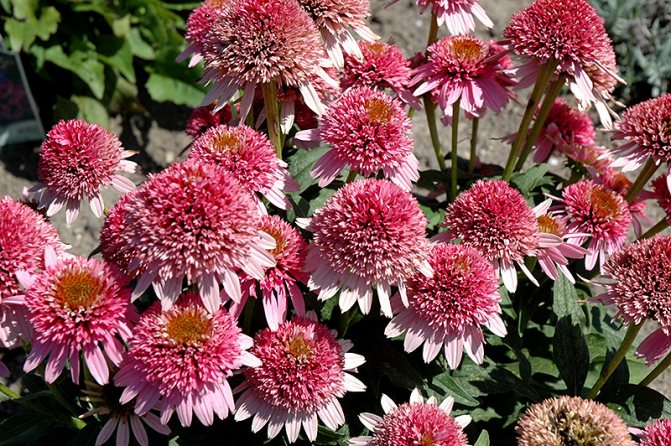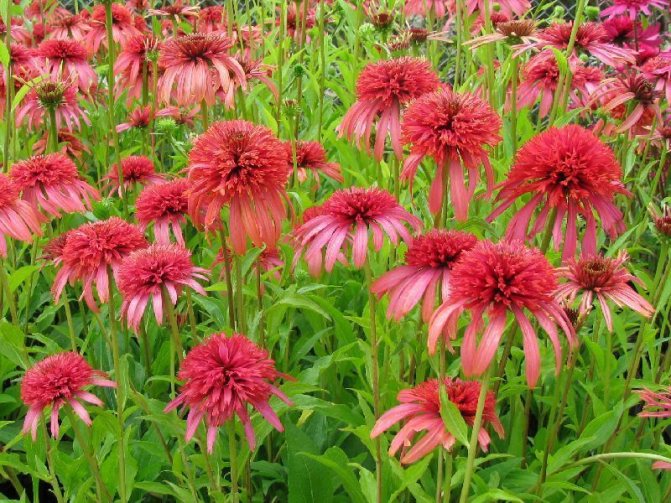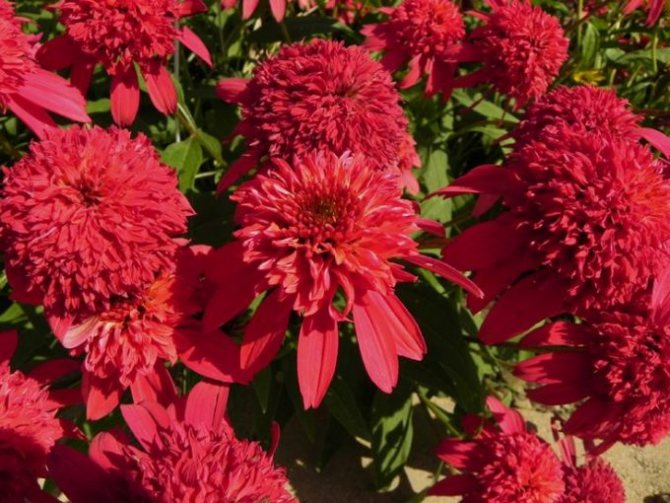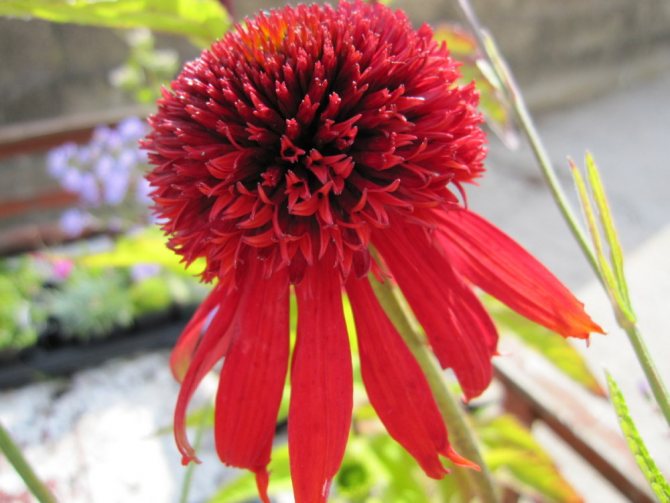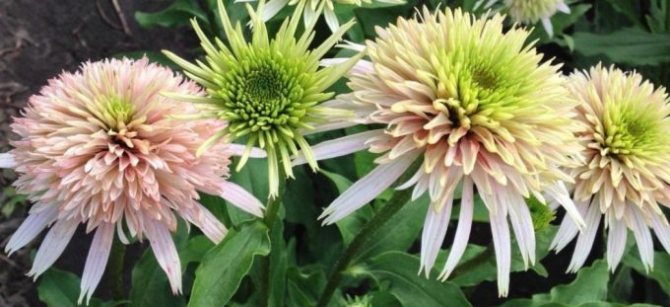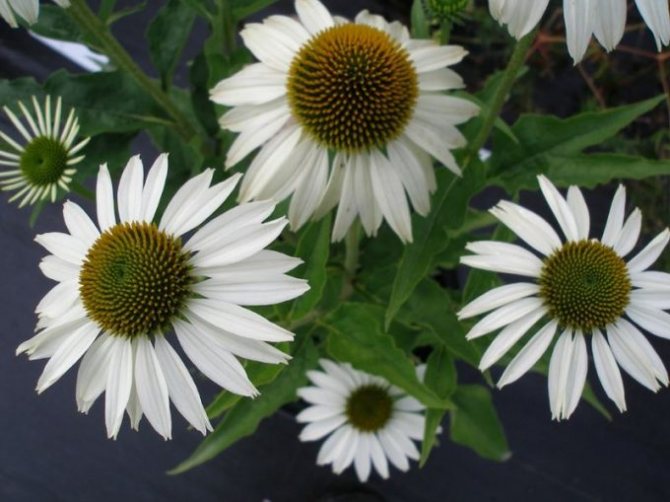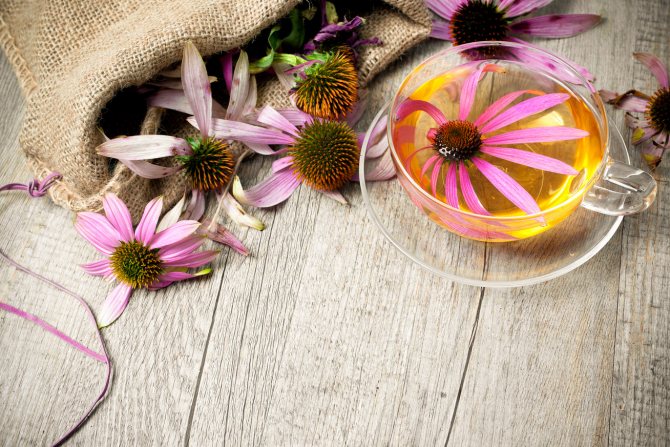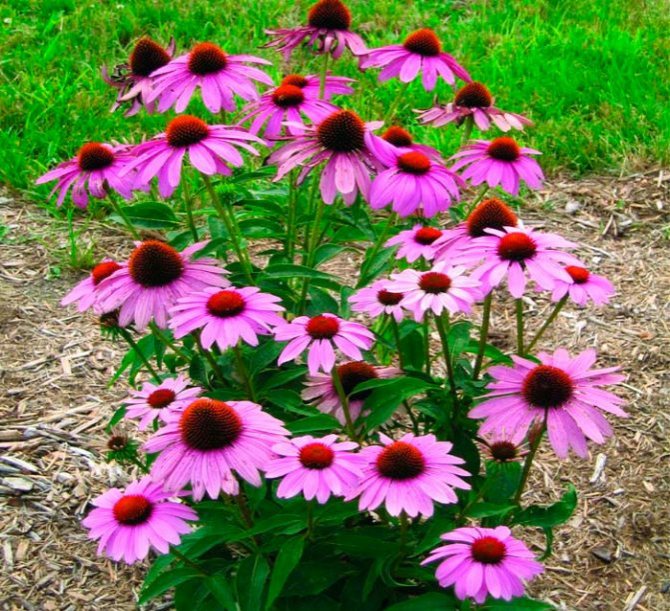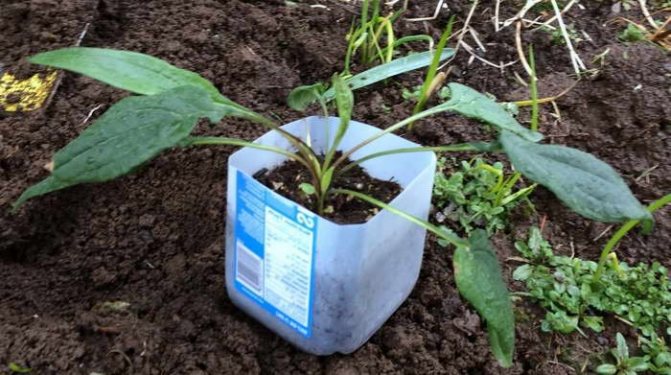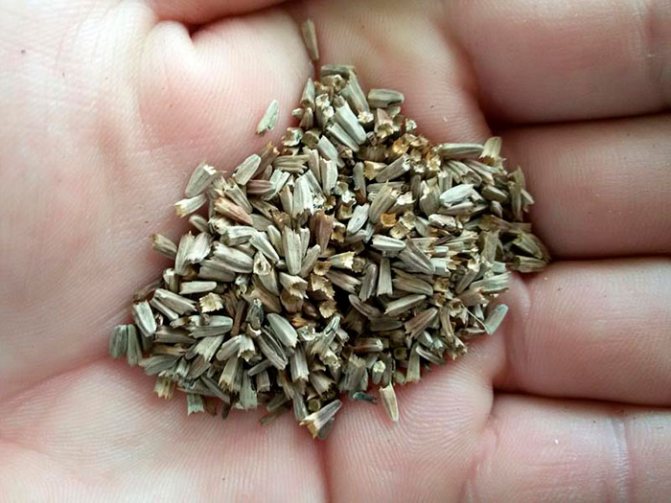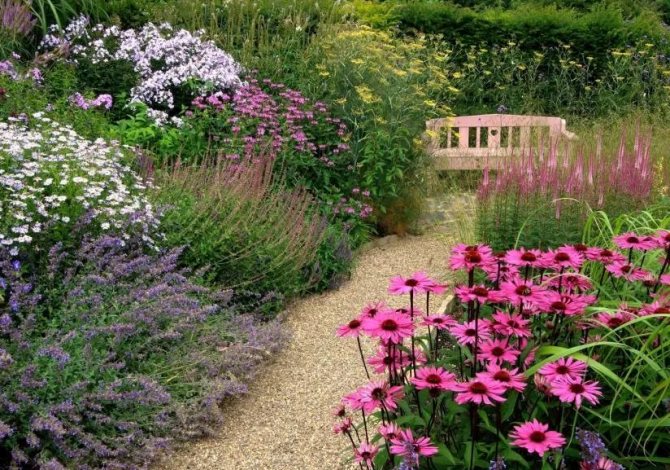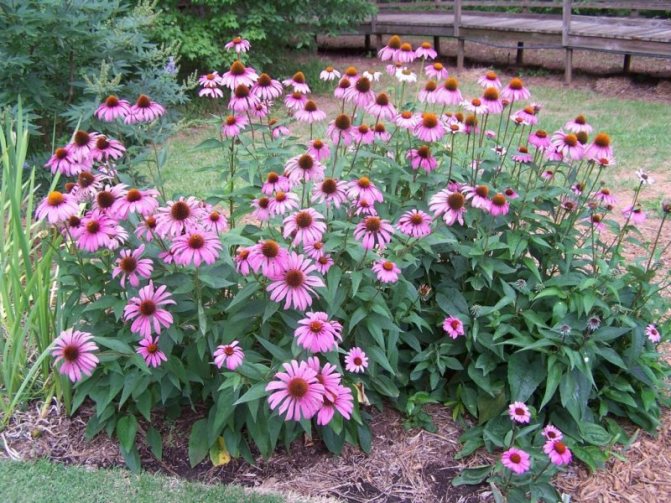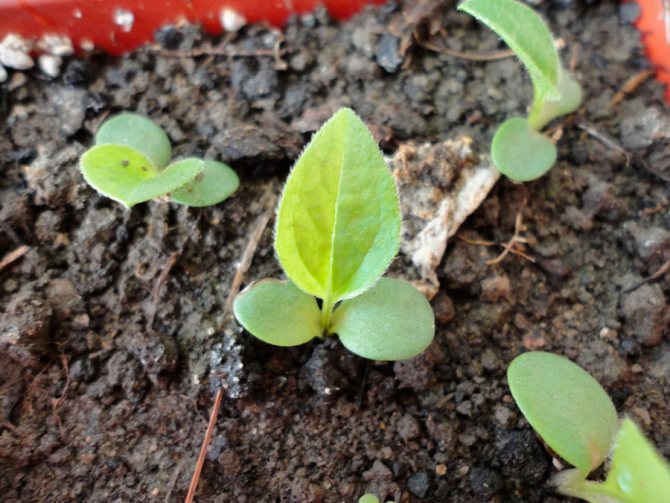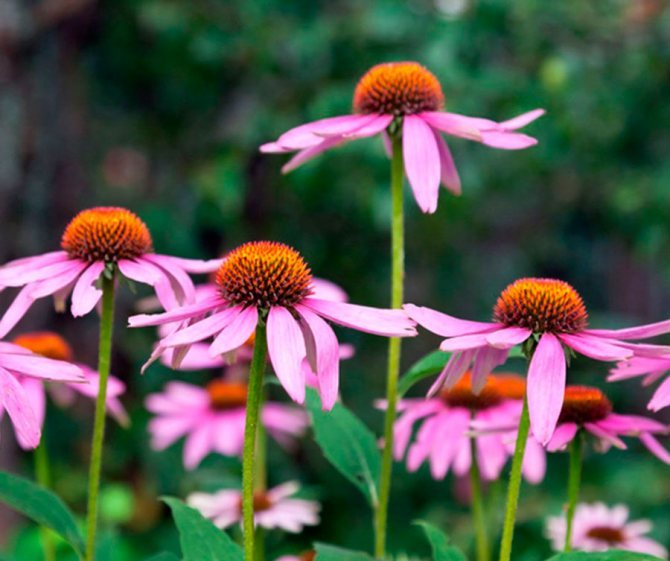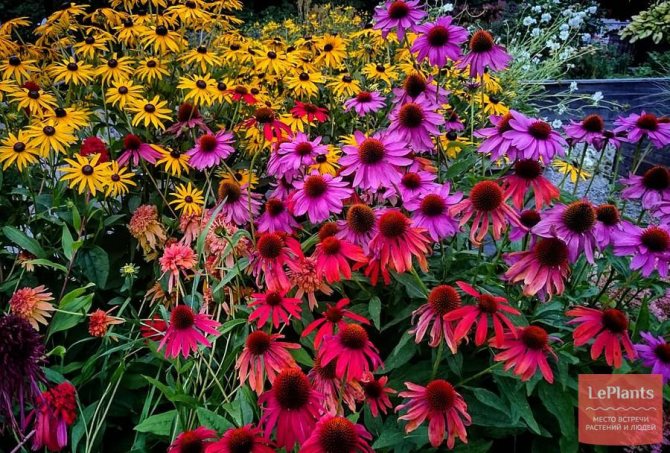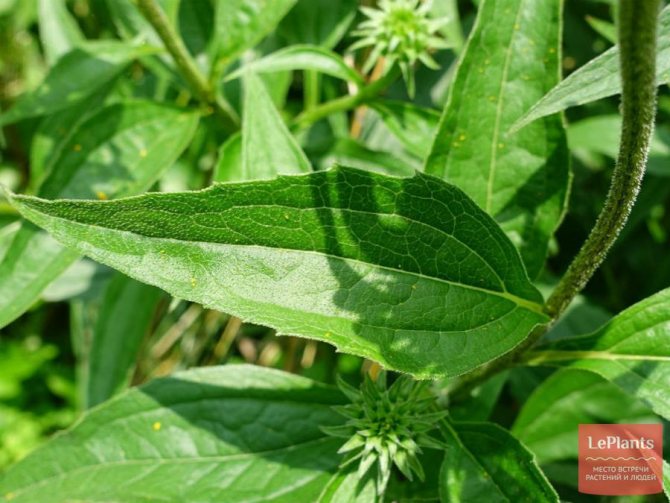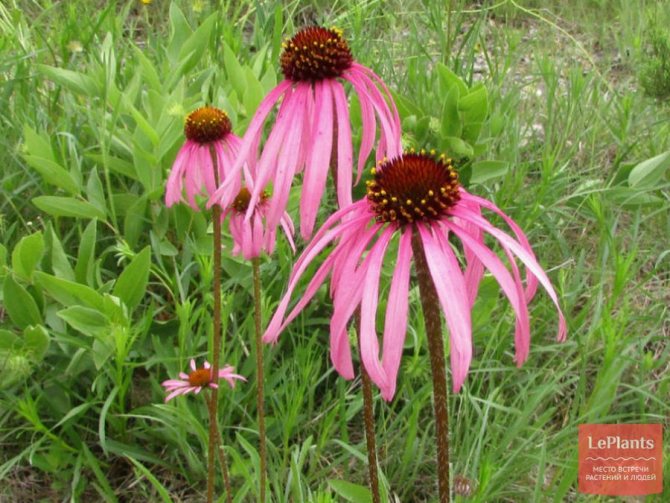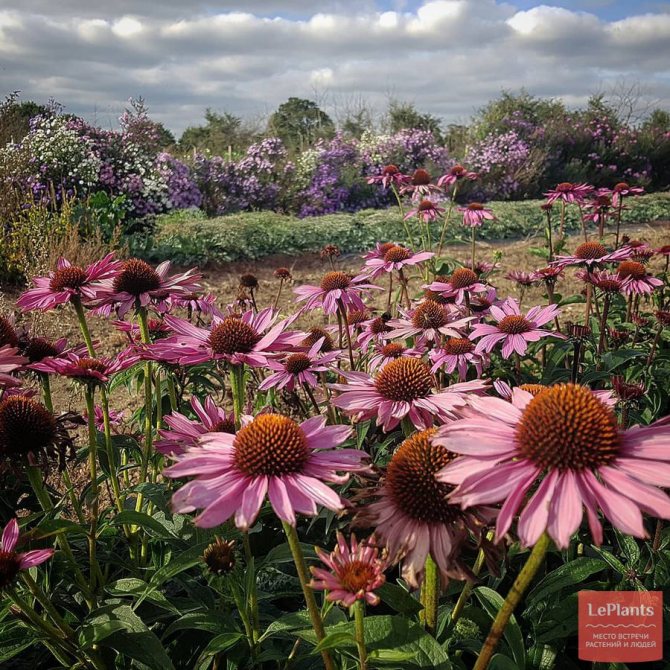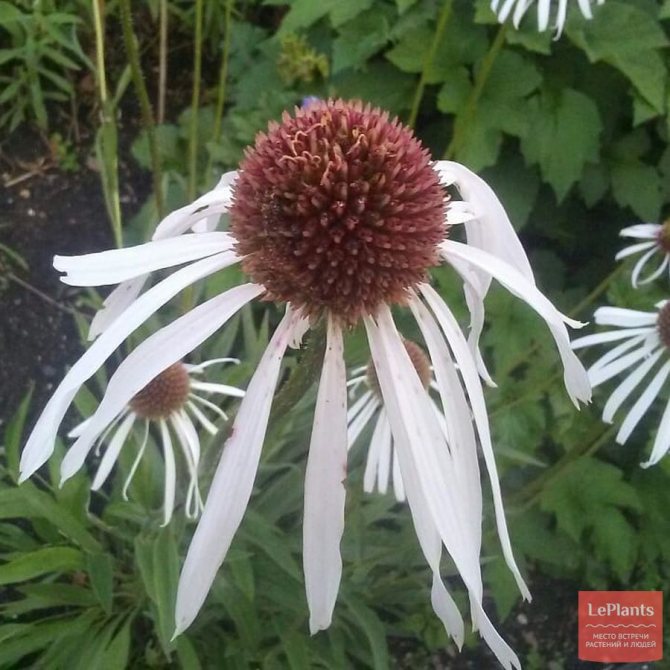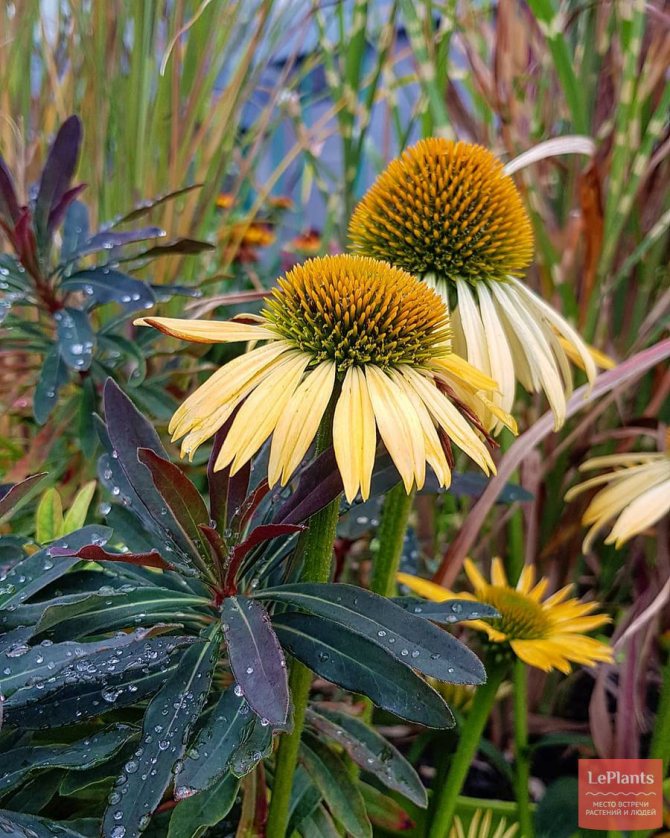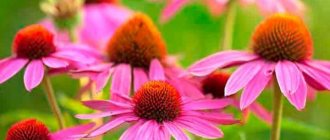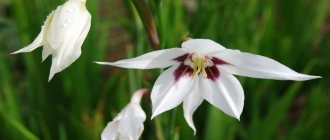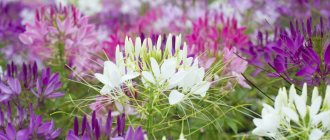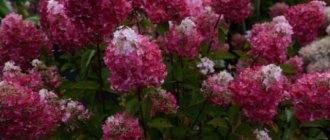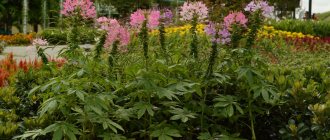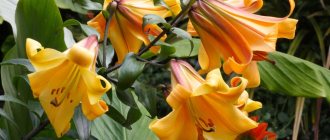The origin and appearance of echinacea
The homeland of echinacea is the eastern part of the United States of America; the plant appeared in European gardens only 300 years ago. The flower belongs to the Astrov family, it was first described by Karl Linnaeus. He considered that the plant belongs to the genus Rudbeky. 41 years later, in 1794, the botanist Mönch singled out the plant as a separate genus. The name of the flower can be translated from Greek as "prickly".
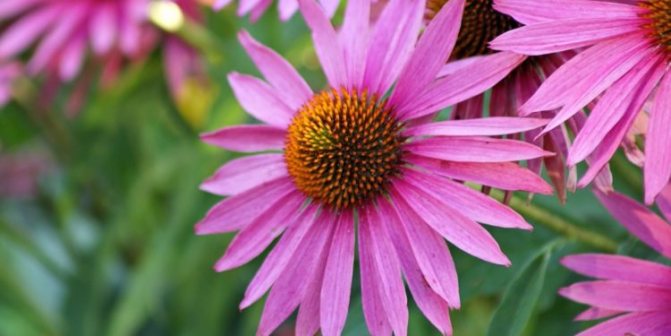
Echinacea is a useful medicinal and food culture
The plant is common in steppes and rocky hills. The Indians knew about its healing power - they grew echinacea almost on an industrial scale!
Echinacea flower description
Echinacea is a flower that can reach a height of about one and a half meters. The stem of the plant is rather rough, rough, the leaves are wide, tapering towards the ends. The appearance of the inflorescences resembles a chamomile, while the petals can have different shades:
- red;
- white;
- pink;
- yellow.
The flowers are ligulate, single-row, collected in single inflorescences. The diameter of one flower usually does not exceed ten centimeters. Fruits are achenes, their ripening occurs in August-September.
Flowering begins in the second half of July and lasts up to two months.
Echinacea: perennial flower
In general, five types of herbaceous plants are known, called echinacea, but the stable and effective perennial Echinacea purpurea has become widespread in horticulture.
Echinacea purpurea
Echinacea is a flower that belongs to the Astrov family. It was described by K. Linnaeus. The plant has a healing effect on the body. It is used in folk and traditional medicine. It is also popular in landscape design.
Echinacea is a perennial rhizomatous flower. In natural conditions, it grows on the North American continent. The flower is common on rocky hills and steppes. Even the American Indians knew about the healing properties of this plant, so it was grown and used on a large scale.
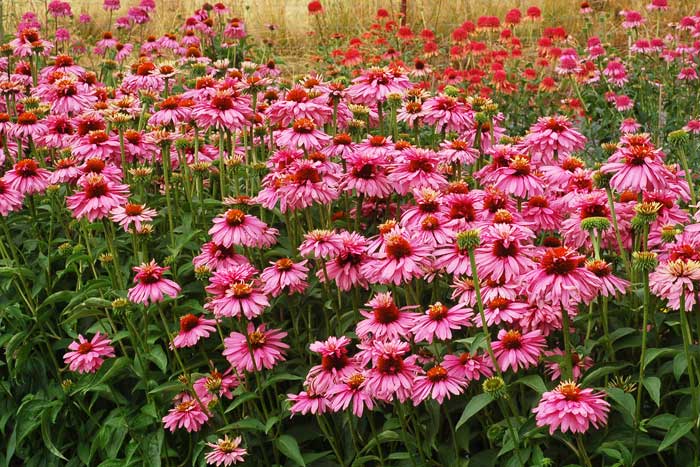

What does echinacea look like?
The name of the flower is translated as "prickly hedgehog". This is due to the fact that its stem is rough. Plant height can reach 1.5 m. The leaf plates are wide, tapering towards the end. The inflorescences resemble chamomile. Flowers can be red, white, yellow and pink. Flowering begins in the second half of July and lasts two months.
Benefits of Echinacea
Pelargonium PAC Viva Madeleine, Carolina and other varieties
The flower looks great in landscape-type flower beds. It can be the main accent, or it can play the role of a background for other plants. Having planted echinacea on his site, the gardener gets a unique plant for which there are many uses!
Application in traditional medicine
The main beneficial property of echinacea is its healing effect on the human body. All parts of the plant contain various vitamins, essential oils, resins, organic acids, and minerals. Separately, it should be said about the presence of such antioxidants as echinocin and echinolone.
This means that Echinacea (flowers, leaves and roots) has the following effects:
- antimicrobial;
- antiviral;
- immunostimulating;
- wound healing.
Echinacea is indicated for obesity, infertility, it relieves cravings for alcohol and smoking. Of course, you can use any part of the plant only after consulting a doctor!


Echinacea has many healing properties
Speaking about useful properties, the following should be noted:
- improved blood composition;
- normalization of blood clotting;
- the formation of healthy tissue after surgery;
- increased immunity;
- improved metabolism;
- restoration of mental health;
- getting rid of tonsillitis and tonsillitis;
- fast wound healing.
Important! Echinacea is a powerful allergen, and therefore the use of the plant and preparations based on it is contraindicated during pregnancy and lactation. Children and allergy sufferers should not take such medications.
Use in garden design
The plant looks best in the background, it can be planted next to yarrows, dahlias, phlox and other ornamental crops. A good perennial in combination with conifers, suitable for creating rustic compositions in the garden.
Echinacea: use for children
How to protect a child from infection, how to strengthen his already weakened immune system? This is the main question that worries modern parents. Most often, children are prone to colds. According to most therapists, echinacea preparations can be prescribed even to children at an early age (from one year). The best thing to do for a child is to prepare teas based on this plant. You can buy ready-made preparations, herbs, dried flowers, leaves or roots of Echinacea at the pharmacy and brew according to the instructions on the package. Just be sure to study their origin, as well as their authenticity.
It is advisable to have a thermos for brewing. For one liter of water, 2 tbsp is added. l. dried herbs. All this is aged for half an hour, and then consumed as ordinary tea. Not after meals, but in between meals. You can add a few drops of lemon juice and one or two teaspoons of natural honey to your tea. To feel the effect, when consumed, at least 1.5 hours after a meal, or 1 hour before it, must pass. In this case, echinacea for children will be a really effective remedy.
The plant is produced in various forms, there are also special forms for children: in preparations, granules, dried form, tincture. But according to experts, children's preparations with echinacea differ significantly from those medicinal products that are intended for adults. You should not offer your child an alcoholic tincture if you took it for your own needs. If an allergic reaction occurs, then you should stop using the herb echinacea.
Echinacea tincture on alcohol is suitable only for older children (from 12 years old), and then in a diluted form, in proportions of 1: 3 (one part of the tincture and three parts of water). Should be taken before meals, 3 times a day. The child can drink a few drops of the diluted tincture at a time. To strengthen the body, it is enough to drink the tincture for 1-2 weeks. In order to help with the treatment of a specific disease - 3-8 weeks (as the doctor says!). Side effects are minimal - only an allergic reaction and even then rarely! The main thing is to observe the dosage and not exceed the maximum duration of the course.
Other types and varieties of echinacea
Pelargonium Yug Shukar, Aksinya, Ireland and other varieties
Echinacea is a flower that, in addition to its purple appearance, has a number of other varieties and varieties. For example, in the wild, there are nine species.
Echinacea Hot Papaya
This variety will appeal to those gardeners looking for plants that can become a bright accent. In the middle of summer, orange-red flowers emerge on the stems, topped with large double pompoms that have the color of papaya.
This variety has a rich aroma, and its petals do not fade even in the hottest sunny summer.


Echinacea Hot Papaya
Echinacea Ayherb
Echinacea Ayherb differs from other varieties in a delicate pinkish tint. The average diameter of the flowers is about 10 centimeters, the height of the plant reaches 80 centimeters.
Echinacea Eccentric
Echinacea Eccentric can be called one of the most outstanding varieties. On elastic and strong stems, the height of which reaches 60 centimeters, in the second half of July, double flowers of a bright red hue with a rich purple tint appear. At the end of summer, the flowers take on an orange tone.
Echinacea White
Echinacea White is a perennial plant that can grow up to 80 centimeters tall. As the name suggests, the petals are white. By the way, it is this echinacea that has the highest healing properties.
Echinacea yellow
Yellow Echinacea has some of the largest flowers. They are colored deep yellow. The heart of each inflorescence has a pleasant chocolate shade. In order for the plant to develop and grow normally, it needs loose, drained soil and open, sunny places.
Echinacea Milkshake
Large flowers are also typical for Echinacea Milkshake. Outwardly, they resemble large pom-poms with a light green tint. The middle part of the flowers is orange, the edges of the petals are pale white. The Milkshake Echinacea shrub can grow up to one and a half meters.
Echinacea Guava
Due to the fact that the growth of Echinacea of this variety reaches 100 centimeters, it is excellent for growing in flower beds and in a mixborder. The flowers are large, double, with bright red petals. Sometimes a purple hue can be seen at the base of the flower.
Also, the following varieties of Echinacea are popular among gardeners:
- Butterfly is a flower with a brown core and pink petals.
- Burgundy - as the name implies, the flowers of this variety of Echinacea are colored in the color of Burgundy wine.
- Fruit jelly - flowers have a bright orange tint.
- Red hat - with pink petals and a bright scarlet core.
- Twister - with a lilac-greenish tint of petals.
All of these varieties are good both as a single bush and in combination with other ornamental horticultural crops.
Features of echinacea
Echinacea is a herbal rhizome that is perennial. The height of vertical rough shoots is 100-150 cm. The basal plates are very extensive and have a rounded shape, the edge is serrated.
The leaves are evenly spaced and their shape is lacent. The structure of the inflorescences includes large baskets with medium tubular flowers, which are of chestnut color. The fruit is a seed with four grains.
Types and varieties
Only nine echinacea are found in nature. Gardeners prefer to cultivate combined types.
- Echinacea purpurea
This is a long-term flower, which reaches up to 1m in elevation. The processes are erect, and the leaves have a lacent configuration, their color is brownish, rather wide, collected in a rosette.
The flowers are baskets, in the middle of which there are tubular flowers of a chestnut tone, and on the edge there are pinkish-purple flowers reaching a span of 40 mm. The most popular types:
- Granatstern. The bush reaches up to 1.3 m, and its baskets are 13 cm. The flowers have a plum color and are slightly pubescent.
- Sonnenlach. It reaches a height of up to 1.4 m. Its inflorescences are 10 cm in diameter, these include lanceolate flowers of dark red color, the length of which is 35 mm, and at the top they have 2-3 teeth.
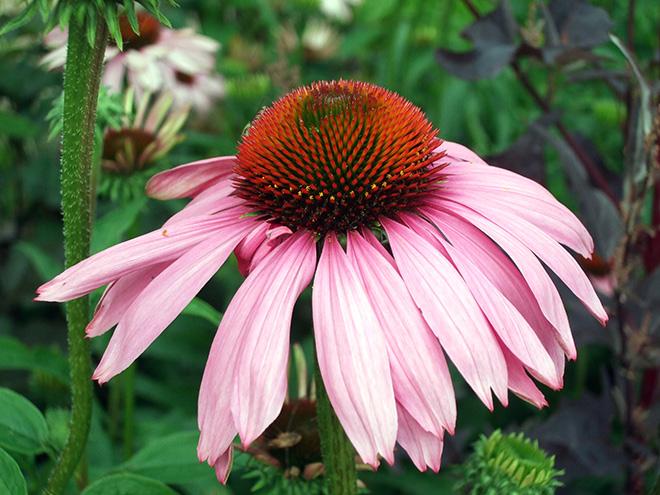

- Echinacea Sunset
It is a hybrid plant, bred by crossing purple and paradoxical echinacea. These species have excellent qualities that have been combined.
They have fairly large inflorescences, a pleasant aroma, beautiful shades, curved leaves. There are subspecies with unusual colors: silver, plum, orange, golden.
Earlier we talked about another amazing flower for your site - Erantis.
The most common varieties:
- Yulia. The plant is compact, as its height is only 0.45 m. In early summer, orange-toned baskets bloom. Flowering is long enough.
- Cleopatra... The diameter of the flowers is 75 mm, the color of the inflorescences is golden, the buds of the reed are arranged horizontally.
- Evening Glow. The inflorescences are golden in color with a horizontal stripe of orange color, and in the middle there are tubular flowers protruding beyond a dark cone.
- Cantaloupe... The baskets are in melon color. The tongue petals are arranged in two rows and resemble a toad. And the shaggy hemisphere includes dark-colored buds.
- Passion flut. It is an unusual species because the buds are yellow and rolled into a tube. They are constant with respect to drought and are very easy to care for.
- Double Scoop Cranberry. This species is easy to care for. Baskets can be of various colors. Florists are used to compose flower arrangements.


Beneficial features
The herb of this plant contains many useful trace elements:
- polysaccharide;
- saponin;
- resin;
- oils;
- acid and many others.
Echinacea preparations have antimicrobial, antifungal, antiviral effects. Also, such funds strengthen the immune system, relieve stress.
Tincture of this plant helps to increase potency and quick healing of burns. The juice squeezed from vigorous plants is used in non-standard medicine to heal wounds, and when it is applied from the inside, blood clotting accelerates.
Echinacea purpurea is known in a large number of countries. Means of such a flower in Germany are used in the treatment of angina pectoris, chronosepsis. Some scientists claim this species has the same medicinal properties as ginseng.


Here are some recipes for echinacea-based remedies that you can make at home if needed:
- Dyeing. Take a 500 ml glass jar and fill it with freshly cut echinacea flowers. Then fill them with alcohol and close the container with the twist lid. Remove the container to an unlit place for forty days. Then the tincture is poured into another container. Helps with overexertion, depression, infections.
- Decoction of roots. 300 mg of water should be mixed with 1 large spoonful of chopped echinacea roots. The mixture is placed in a water bath and boiled for 30 minutes. After the broth has cooled, it must be drained. Drink 1-2 large spoons 3 or 4 times a day. Helps with colds, fatigue and the most dangerous infectious diseases.
Contraindications: Echinacea products sometimes cause an allergic reaction. They should not be used by pregnant women, as well as by breastfeeding, as well as people with multiple sclerosis, progressive tuberculosis, leukemia, collagenosis. And they cannot be used by people with individual intolerance. And in general, before using such drugs, it is recommended to consult with a specialist.
Echinacea purpurea: planting and care in the open field
Rose Ballerina and other musk varieties with description
Having decided to plant echinacea on your site, it is important to understand that in the first year of life it is hardly possible to see flowers - during this time, only a rosette will form. The plant will bloom only in the second year. Planting a perennial is a simple procedure.
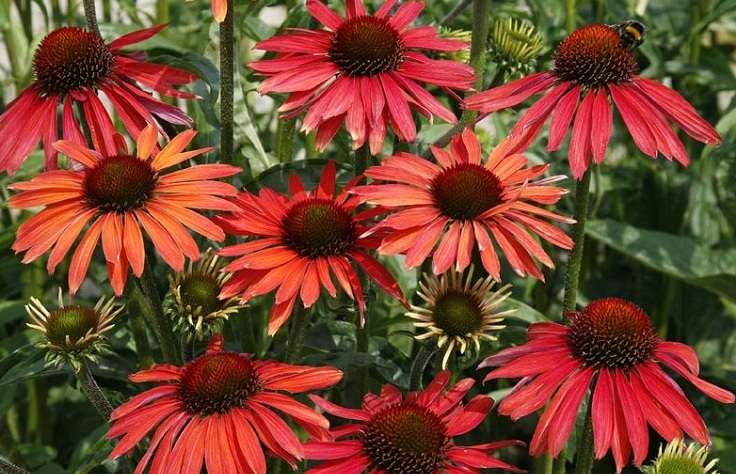

Echinacea
How and when to plant echinacea
The optimal time for planting seedlings in a permanent place in the open field is autumn or spring.The site should be sufficiently sunny, with a nutritious neutral or slightly alkaline soil. Echinacea does not like light sandy soil or moist soil.
Important! In the shade or even partial shade, the thermophilic beauty Echinacea can die.
Step-by-step planting process
How to properly plant seedlings in a permanent place:
- Prepare the holes - their depth should be about five centimeters. It is important to keep the distance between them - about 30 cm. The depth of the hole should slightly exceed the length of the plant's root system.
- Place a small amount of compost on the bottom of the hole.
- Plant echinacea.
- Water the plant thoroughly.
In the event that Echinacea grew in a container, the planting hole should be slightly larger, the optimal depth is 40 cm. It should be filled in one third with a mixture of equal parts of sand, compost and garden soil.
Important! It is necessary to plant the plant along with a clod of earth to the same depth at which it grew in the container.
Echinacea gives health and beauty
Echinacea purpurea (Echinacea purpurea) is a perennial herb from the family Asteraceae or Asteraceae, 80-120 cm high. Originally from the eastern United States. This is a tall and extraordinarily beautiful plant. Inflorescences are large, purple-violet baskets. Depending on the climate, it starts blooming in late May or early July. It is cultivated as an ornamental and medicinal plant.
Echinacea plant is light-loving, winter-hardy, prefers moist fertile soils. Does not require special care. Her vitality is approximately at the level of pharmaceutical chamomile. The plant blooms in the second year of life. Duration of flowering up to 75 days. Echinacea purpurea reproduces well by seeds. It is grown through seedlings or by sowing in the ground. Sowing is recommended to be carried out in spring with dry seeds, when the ground warms up to 10 degrees, to a depth of 2-3 cm, in a wide-row method with 45 cm row spacing. Seedlings appear 15-30 days after sowing. Plant feeding is carried out only in the second year in the regrowth phase in early spring.
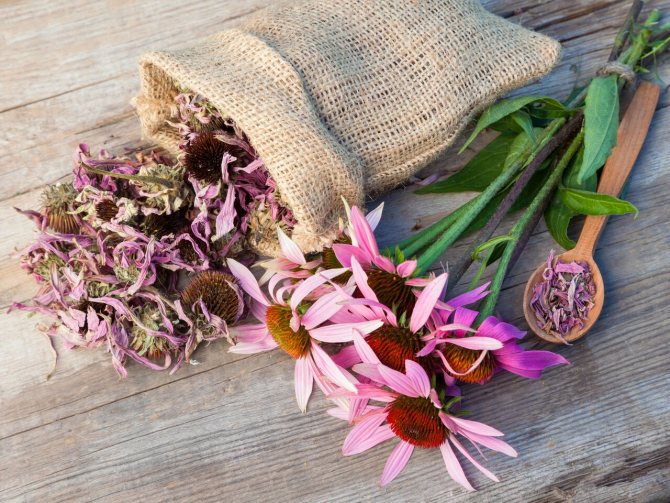

By sowing and growing this plant, we will receive a drug that will relieve us of many diseases and increase immunity. If you want to grow it for medicinal purposes, then the collection of herbs for raw materials is carried out in the second year of life in the phase of the first half of mass flowering - July.
Grass, leaves, flowers, stems, rhizomes and roots are used as medicinal raw materials. The grass is harvested during flowering, cutting off flowering shoots 25-35 cm long, which are consumed fresh, and also dried in the shade. Extraordinarily healing rhizomes and roots are dug up in the fall (in September-October), when the content of medicinal substances in them reaches the highest level, then they are cleaned, washed from the ground, dried and cut into pieces. Raw materials are dried at a temperature of 40-45 degrees or in well-ventilated rooms.
Echinacea Garden Care
Echinacea is a completely unpretentious flower to care for. However, a small amount of attention will still have to be paid to the plant.
Watering mode
The flower should be watered in the evening. Purple Echinacea needs abundant and frequent moisture in the soil. In order to retain moisture at the roots, it is recommended to mulch the soil.
Top dressing
Echinacea is an herb that needs nutrients in its second year. Before flowering, you should feed the plant with rotted compost, you can also add wood ash. This will make the bloom more lush. Experienced growers recommend feeding flowers before flowering and after the plant has faded.
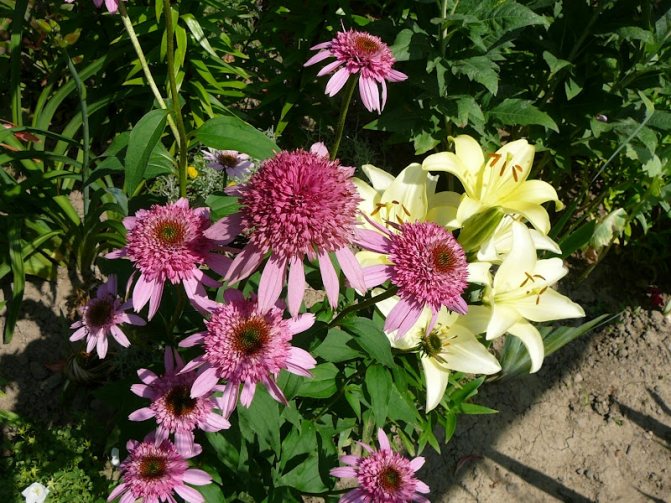

Caring for blooming echinacea will require attention and care.
Features of care during flowering
During the flowering period, special complexes of mineral fertilizers should be applied. If you plan to use the flower for medicinal purposes, you should refuse to make additional fertilizing.
Important! Weeds do a lot of damage to purple echinacea.Weeding should be carried out regularly, removing weeds before they begin to take nutrients from the soil.
What to do when flowering is over
After the echinacea finishes flowering, you need to prepare it for winter. To do this, remove the inflorescences, cut off the shoots, cover the bushes with spruce branches or non-woven material.
Preparing for winter
Echinacea is a perennial that is frost-resistant. However, if not enough snow falls in winter, the flower may freeze and die. In order to prevent this, in the last days of October, all shoots should be cut off from the plants. Thoroughly sprinkle the root collar with mulch and cover with dry foliage or spruce branches on top.
Perennial flower
Seedling young bushes of Echinacea are very delicate, so it is better to postpone their planting in open ground until the end of May. During this period, there is practically no threat of frost on the ground. The site for planting is selected in advance.
For planting seedlings, holes are prepared, keeping a distance of up to 30-60 centimeters between them, it all depends on the variety and variety of echinacea. Pour a little rotted compost at the bottom of the hole, add wood ash there, mix the layers slightly. Place the seedling in the center, sprinkle with earth, then water.
Planting care
Clever care when growing echinacea is not required, but plants still do not leave without attention. Otherwise, the seedlings will develop poorly, lose their decorative effect, or may die. Basic care recommendations:
- Plants are watered regularly, but without fanaticism. It is advisable to do this after sunset. Although the flower is hardy, you do not need to leave it dry for a long time, otherwise it will dry out. With an excess of moisture in Echinacea, the deciduous part falls off;
- From time to time, remove weeds under the plants, loosen the soil so that oxygen is better supplied to the roots;
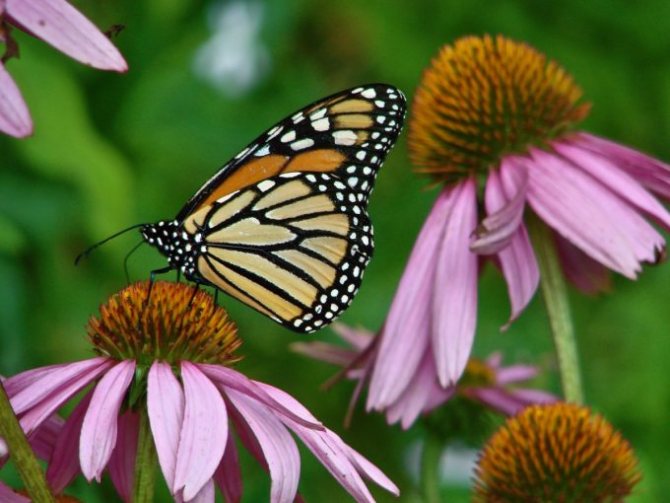

- Echinacea should be fed a couple of times during the summer season. Early in the spring, nitrogen and mineral fertilizers are applied under the plants, and when the first buds appear - phosphorus and potassium compounds;
- To stimulate flowering, it is recommended to cut off the faded inflorescences. For the ripening of the seed, the largest and most beautiful inflorescences are left on the bush. The seeds are harvested after the petals have fallen from the flower;
- Every 3-4 years, it is recommended to transplant echinacea using divisions of the bush. For transplantation, each separated bush should have 2-3 living buds;
- As soon as the first autumn frosts come, the aerial deciduous part of the echinacea is cut off. The remains are covered from above with pine or spruce branches, rotted compost, foliage.
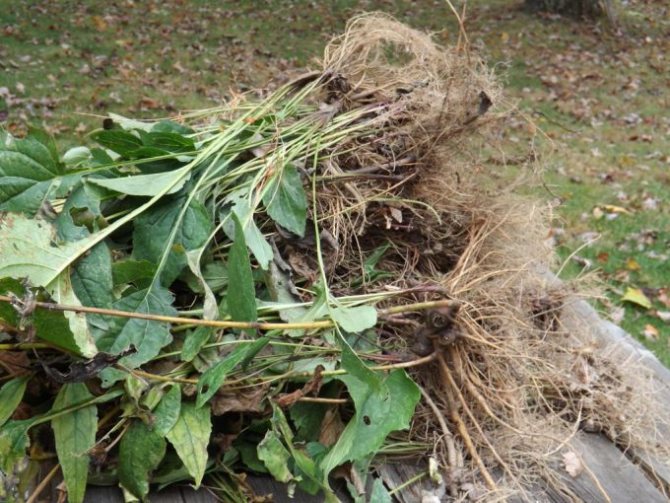

All methods of breeding echinacea
In order to grow echinacea on the site, you can use one of two methods of flower reproduction - vegetative or growing from seeds.
Echinacea propagation by dividing bushes
This method is suitable for plants that are about 2-4 years old. It is recommended to divide the bush in early spring. To do this, you need to dig up the plant, divide it into the required number of parts, each of which must have adventitious roots and a bud. After that, the shoots are placed in a growth stimulator, and then planted in a permanent place.
Important! If the weather is cool, the scions can be planted in a container. Within a month and a half, the bushes will take root - they can be transplanted into the garden.
Growing echinacea from seeds
Echinacea is fairly easy to propagate by seed. They can be planted in pre-prepared containers or directly into open ground. The seeds can be purchased at a specialty store, or can be harvested by hand - at the end of the season from baskets that have a dark shade.
In order for the flowers to bloom in the first year, the seeds should be sown no later than the beginning of February.
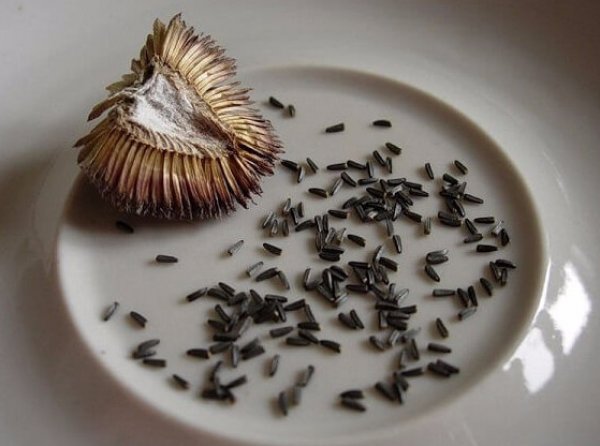

Echinacea seeds
The planting material must be carefully sorted out and dried; it is recommended to plant it at the end of February. In a container with a universal substrate, it is necessary to sow seeds, the optimum depth is five millimeters. From above it is necessary to sprinkle them with a thin layer of ordinary sand - no more than one millimeter, and then moisten with a spray bottle. Cover containers with foil and place in a warm place. The first shoots will appear in one and a half to two months.
Echinacea alcohol tincture


Echinacea tincture on alcohol is known to us better than its other preparations. You can always buy it at the pharmacy, but you can prepare it yourself. Inside, most often they take a 10% tincture of alcohol from perennial roots and all other parts of plants, while a stomach ulcer is very well cured, and stones from the kidneys are dissolved and removed.
Heals prostate adenoma, inflammation of the urogenital area, female inflammation, constipation, vasospasm, gastritis, normalizes and improves all metabolic processes in the body. When coughing, bronchial asthma, rub the back, especially under the shoulder blades, for seven days in a row with alcohol tincture.
Experienced herbalists recommend pouring finely chopped fresh or dry leaves of Echinacea purpurea with alcohol or vodka 1:10, insist for 10 days. Take an infusion of 25-30 drops 3 times a day before meals.
Echinacea root alcoholic tincture. Pour the crushed raw root or flowers in a ratio of 1: 4 with 70% alcohol, leave for a month. Drink a teaspoon three times a day, use externally for compresses for burns and wounds.
Echinacea root extract. Pour fresh chopped root with 95% alcohol so that it covers the root, leave for two weeks. Strain, squeeze out the rest. Drink half an hour before meals, 25-30 drops 3 times a day with water, in case of fatigue, flu as an immunostimulating agent. Keep refrigerated.
It is worth noting that until adolescents reach the age of 20, absolutely all medicinal tinctures, even the most medicinal plants, are strictly prohibited.
Plant diseases and pests
Experienced gardeners say: Echinacea purpurea is resistant to disease and pest attacks. The emergence of problems is possible only due to non-observance of the rules of agricultural technology and climatic conditions.
On hot summer days, the plant can get sick with powdery mildew. It is quite easy to detect this: a white bloom will appear on the echinacea. It is necessary to process flowers with Bordeaux liquid.
Sometimes small spots appear on the leaf plates, the plants begin to wilt. Most likely, these are fungal diseases such as cercosporosis and septoria, which will help to cope with various fungicides.
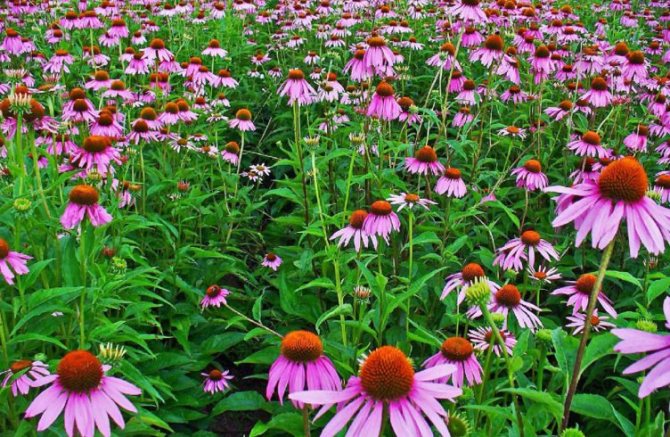

With proper care, the plant does not get sick
The appearance of bugs, slugs and other insects is possible. As for slugs, they must be collected by hand; insecticidal preparations can be used against any other insects.
Important! Diseases and pests appear only when the rules for growing a crop are violated.
Description of the plant
So, echinacea is a herbaceous perennial.
The plant is tall, as it can reach a height of 150 cm. The leaf plates are not the same everywhere. At the base of the root, oval-shaped foliage of large size, located on petioles. The foliage along the stem is sessile and lanceolate.
Echinacea photo
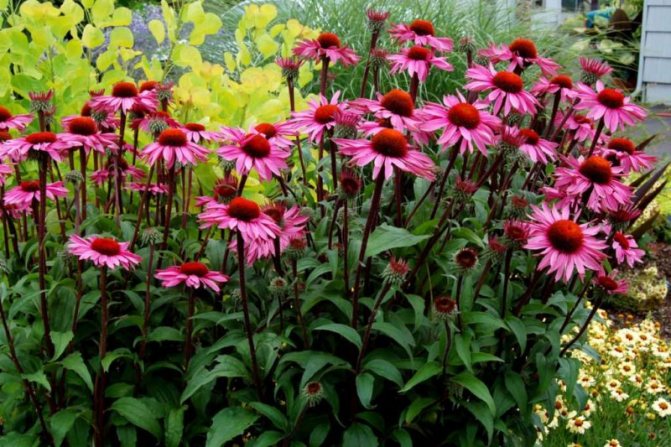

Large baskets act as inflorescences, the central part of which consists of numerous tubular flowers and edging petals of red, pink, white, brown color. After wilting, an achene with four edges is formed in place of the flower.
Flower growing tips from experienced gardeners
Experienced flower growers recommend adhering to the following rules:
- Echinacea can be grown in the same place for no more than 5 years.After this, the plants should be dug up, divided into several bushes and planted in new places.
- Before planting, it is necessary to prepare the substrate: for this, combine garden soil, compost and river sand in equal parts. With this composition, it is necessary to fill the holes for plants by a third.
- It is not enough just to sow the seeds - they need constant moisture, otherwise they simply will not sprout.
- For the winter, Echinacea purpurea is recommended to be covered with a prepared oak leaf.
There is nothing difficult in planting and caring for echinacea. On top dressing, timely removal of weeds and watering, it will react with lush bright flowering. In addition, all parts of the flower contain useful substances, which is a pleasant addition to its attractive appearance.


